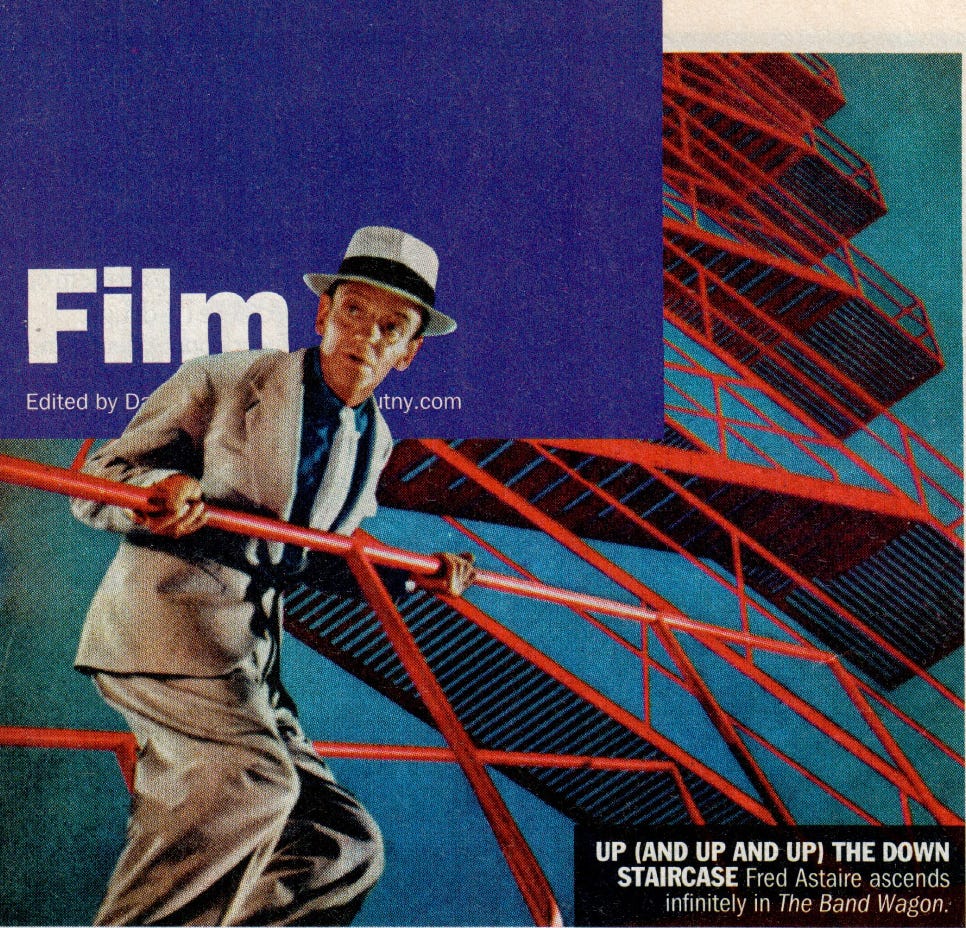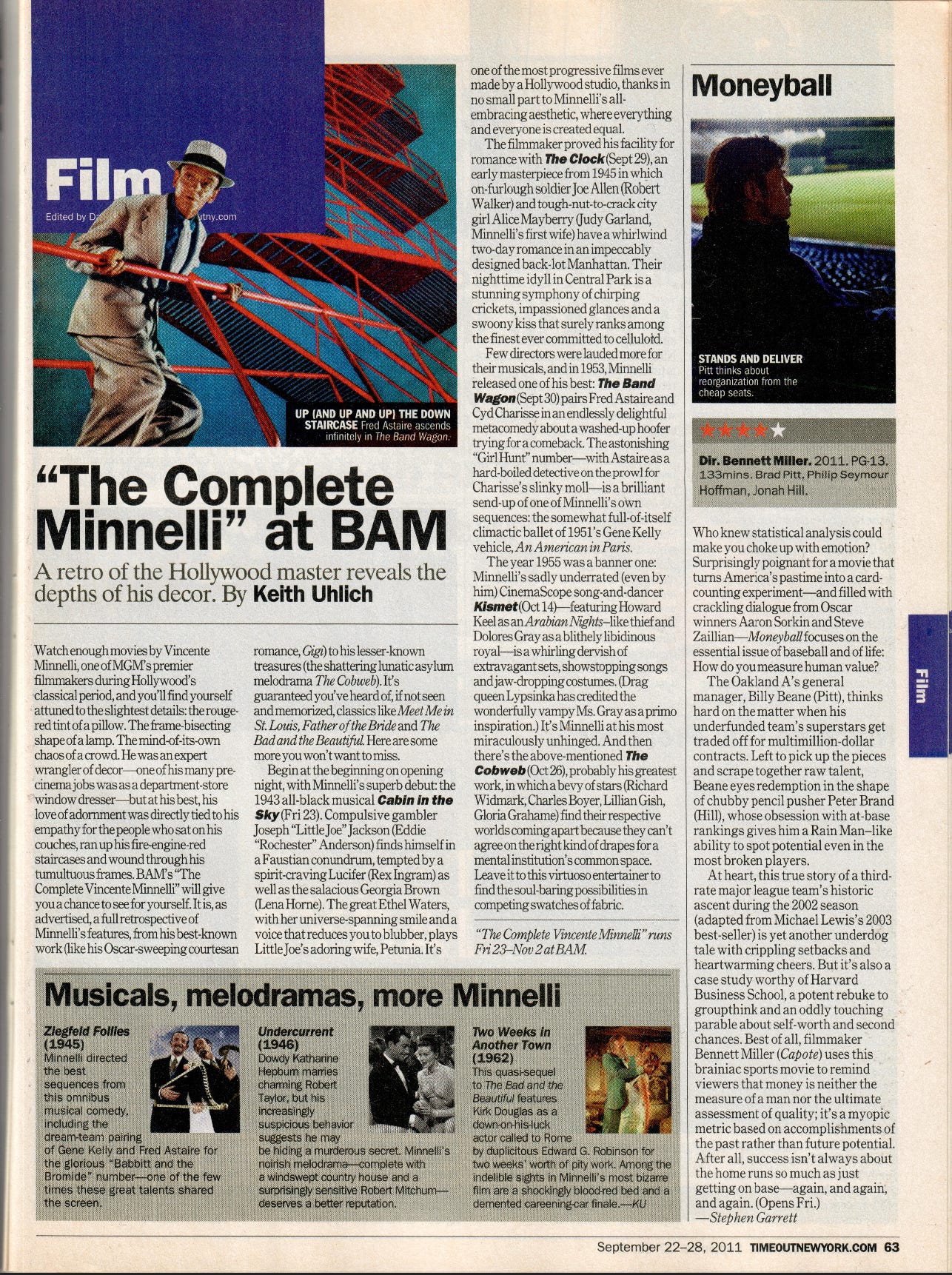"The Complete Minnelli" at BAM
Time Out New York Project: Issue #829, September 22-28, 2011
A retro of the Hollywood master reveals the depths of his decor.
Watch enough movies by Vincente Minnelli, one of MGM’s premier filmmakers during Hollywood’s classical period, and you’ll find yourself attuned to the slightest details: the rouge-red tint of a pillow. The frame-bisecting shape of a lamp. The mind-of-its-own chaos of a crowd. He was an expert wrangler of decor — one of his many pre-cinema jobs was as a department-store window dresser — but at his best, his love of adornment was directly tied to his empathy for the people who sat on his couches, ran up his fire-engine-red staircases and wound through his tumultuous frames. BAM’s “The Complete Vincente Minnelli” will give you a chance to see for yourself. It is, as advertised, a full retrospective of Minnelli’s features, from his best-known work (like his Oscar-sweeping courtesan romance, Gigi) to his lesser-known treasures (the shattering lunatic asylum melodrama The Cobweb). It’s guaranteed you’ve heard of, if not seen and memorized, classics like Meet Me in St. Louis, Father of the Bride and The Bad and the Beautiful. Here are some more you won’t want to miss.
Begin at the beginning on opening night, with Minnelli’s superb debut: the 1943 all-black musical Cabin in the Sky (Fri 23). Compulsive gambler Joseph “Little Joe” Jackson (Eddie “Rochester” Anderson) finds himself in a Faustian conundrum, tempted by a spirit-craving Lucifer (Rex Ingram) as well as the salacious Georgia Brown (Lena Horne). The great Ethel Waters, with her universe-spanning smile and a voice that reduces you to blubber, plays Little Joe’s adoring wife, Petunia. It’s one of the most progressive films ever made by a Hollywood studio, thanks in no small part to Minnelli’s all-embracing aesthetic, where everything and everyone is created equal.
The filmmaker proved his facility for romance with The Clock (Sept 29), an early masterpiece from 1945 in which on-furlough soldier Joe Allen (Robert Walker) and tough-nut-to-crack city girl Alice Mayberry (Judy Garland, Minnelli’s first wife) have a whirlwind two-day romance in an impeccably designed back-lot Manhattan. Their nighttime idyll in Central Park is a stunning symphony of chirping crickets, impassioned glances and a swoony kiss that surely ranks among the finest ever committed to celluloid.
Few directors were lauded more for their musicals, and in 1953, Minnelli released one of his best: The Band Wagon (Sept 30) pairs Fred Astaire and Cyd Charisse in an endlessly delightful metacomedy about a washed-up hoofer trying for a comeback. The astonishing “Girl Hunt” number — with Astaire as a hard-boiled detective on the prowl for Charisse’s slinky moll — is a brilliant send-up of one of Minnelli’s own sequences: the somewhat full-of-itself climactic ballet of 1951’s Gene Kelly vehicle, An American in Paris.
The year 1955 was a banner one: Minnelli’s sadly underrated (even by him) CinemaScope song-and-dancer Kismet (Oct 14) — featuring Howard Keel as an Arabian Nights–like thief and Dolores Gray as a blithely libidinous royal — is a whirling dervish of extravagant sets, showstopping songs and jaw-dropping costumes. (Drag queen Lypsinka has credited the wonderfully vampy Ms. Gray as a primo inspiration.) It’s Minnelli at his most miraculously unhinged. And then there’s the above-mentioned The Cobweb (Oct 26), probably his greatest work, in which a bevy of stars (Richard Widmark, Charles Boyer, Lillian Gish, Gloria Grahame) find their respective worlds coming apart because they can’t agree on the right kind of drapes for a mental institution’s common space. Leave it to this virtuoso entertainer to find the soul-baring possibilities in competing swatches of fabric.



